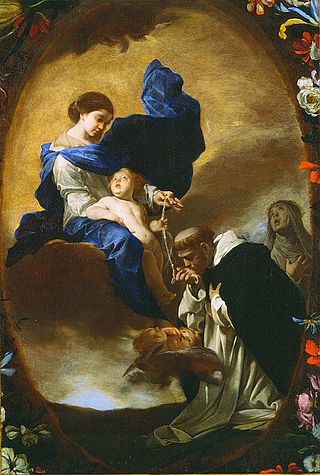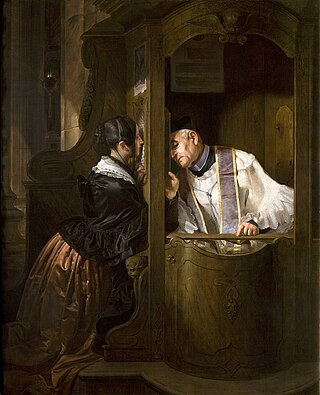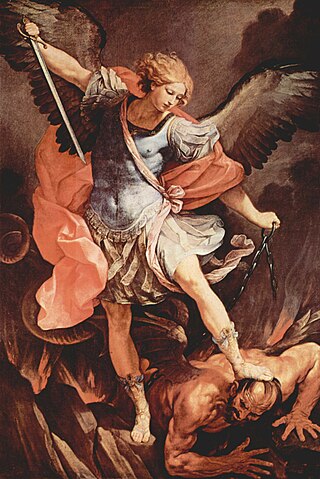
The Rosary, also known as the Dominican Rosary, refers to a set of prayers used primarily in the Catholic Church, and to the physical string of knots or beads used to count the component prayers. When referring to the prayer, the word is usually capitalized ; when referring to the prayer beads as an object, it is written with a lower-case initial letter.

The epiclesis refers to the invocation of one or several gods. In ancient Greek religion, the epiclesis was the epithet used as the surname given to a deity in religious contexts. The term was borrowed into the Christian tradition, where it designates the part of the Anaphora by which the priest invokes the Holy Spirit upon the Eucharistic bread and wine in some Christian churches. In most Eastern Christian traditions, the Epiclesis comes after the Anamnesis ; in the Western Rite it usually precedes. In the historic practice of the Western Christian Churches, the consecration is effected at the Words of Institution though during the rise of the Liturgical Movement, many denominations introduced an explicit epiclesis in their liturgies.

The Angelus is a Catholic devotion commemorating the Incarnation of Christ. As with many Catholic prayers, the name Angelus is derived from its incipit—the first few words of the text: Angelus Domini nuntiavit Mariæ. The devotion is practised by reciting as versicle and response three Biblical verses narrating the mystery, alternating with the prayer "Hail Mary". The Angelus exemplifies a species of prayers called the "prayer of the devotee".

Anglican prayer beads, also known as the Anglican rosary or Anglican chaplet, are a loop of strung Christian prayer beads used chiefly by Anglicans in the Anglican Communion, as well as by communicants in the Anglican Continuum. This Anglican devotion has spread to other Christian denominations, including Methodists and the Reformed.

In Catholic tradition, the Five Holy Wounds, also known as the Five Sacred Wounds or the Five Precious Wounds, are the five piercing wounds that Jesus Christ suffered during his crucifixion. The wounds have been the focus of particular devotions, especially in the late Middle Ages, and have often been reflected in church music and art.

Absolution is a theological term for the forgiveness imparted by ordained Christian priests and experienced by Christian penitents. It is a universal feature of the historic churches of Christendom, although the theology and the practice of absolution vary between Christian denominations.

The Chaplet of the Divine Mercy, also called the Divine Mercy Chaplet, is a Catholic devotion to the Divine Mercy, based on the Christological apparitions of Jesus reported by Faustina Kowalska (1905–1938), known as "the Apostle of Mercy". She was a Polish religious sister of the Congregation of the Sisters of Our Lady of Mercy and canonized as a Catholic saint in 2000.

The Society of the Divine Word, abbreviated SVD and popularly called the Verbites or the Divine Word Missionaries, and sometimes the Steyler Missionaries, is a Catholic clerical religious congregation of Pontifical Right for men. As of 2020, it consisted of 5,965 members composed of priests and religious brothers working in more than 70 countries, now part of VIVAT international. It is one of the largest missionary congregations in the Catholic Church. Its members add the nominal letters SVD after their names to indicate membership in the Congregation. The superior general is Paulus Budi Kleden who hails from Indonesia.
Phos Hilaron is an ancient Christian hymn originally written in Koine Greek. Often referred to in the Western Church by its Latin title Lumen Hilare, it has been translated into English as O Gladsome Light. It is one of some of the earliest known Christian hymns recorded outside of the Bible that is still in use today. The hymn is part of vespers in the Byzantine Rite and the Catholic Church, and also included in some Anglican and Lutheran liturgies.
The Divine Service is a title given to the Eucharistic liturgy as used in the various Lutheran churches. It has its roots in the Pre-Tridentine Mass as revised by Martin Luther in his Formula missae of 1523 and his Deutsche Messe of 1526. It was further developed through the Kirchenordnungen of the sixteenth and seventeenth centuries that followed in Luther's tradition.
Jaroslav Vajda was an American hymnist.

The Chaplet of Saint Michael the Archangel, also called the Rosary of the Angels, is a chaplet approved by Pope Pius IX in 1851.

Thanksgiving after Communion is a spiritual practice among Christians who believe in the Real Presence of Jesus Christ in the Communion bread, maintaining themselves in prayer for some time to thank God and especially listening in their hearts for guidance from their Divine guest. This practice was and is highly recommended by saints, theologians, and Doctors of the Church.
Good Friday Prayer can refer to any of the prayers prayed by Christians on Good Friday, the Friday before Easter, or to all such prayers collectively.

Rosary-based prayers are Christian prayers said on a set of rosary beads, among other cords. These prayers recite specific word sequences on the beads that make up the different sections. They may be directed to Jesus Christ, the Virgin Mary or God the Father.

The Chaplet of the Seven Sorrows, also known as the Rosary of the Seven Sorrows or the Servite Rosary, is a Rosary based prayer that originated with the Servite Order. It is often said in connection with the Seven Dolours of Mary.
In Lutheranism, the Eucharist refers to the liturgical commemoration of the Last Supper. Lutherans believe in the real presence of Christ in the Eucharist, affirming the doctrine of sacramental union, "in which the body and blood of Christ are truly and substantially present, offered, and received with the bread and wine."

Craig Lodge Community is a lay community of the Roman Catholic Church based in Dalmally, Argyll in the west Highlands of Scotland.
The Nicene Creed, composed in part and adopted at the First Council of Nicaea (325) and revised with additions by the First Council of Constantinople (381), is a creed that summarizes the orthodox faith of the Christian Church and is used in the liturgy of most Christian Churches. This article endeavors to give the text and context of English-language translations.

The Litany of the Holy Name of Jesus is a formal prayer in the Catholic Church dedicated to the Holy Name of Jesus. It is one of six formal prayers approved by the Catholic Church for public and private use. This Litany carries a partial indulgence. It is believed that the Litany of the Holy Name of Jesus was written by SS. Bernardine of Siena and John Capistran in the 15th century.












